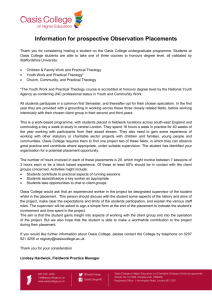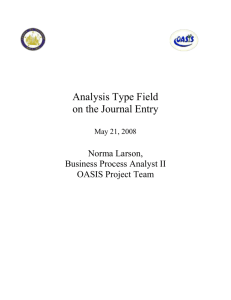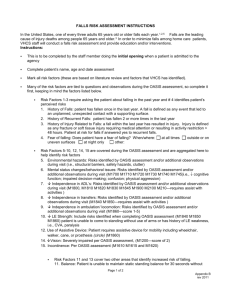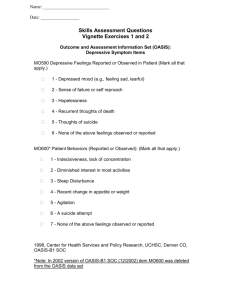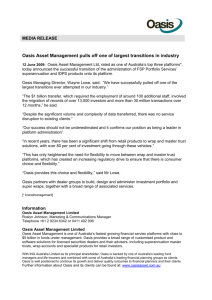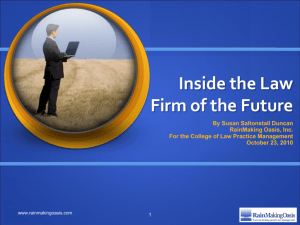April 23, 2015 Marcia Kerz President The OASIS Institute 11780
advertisement
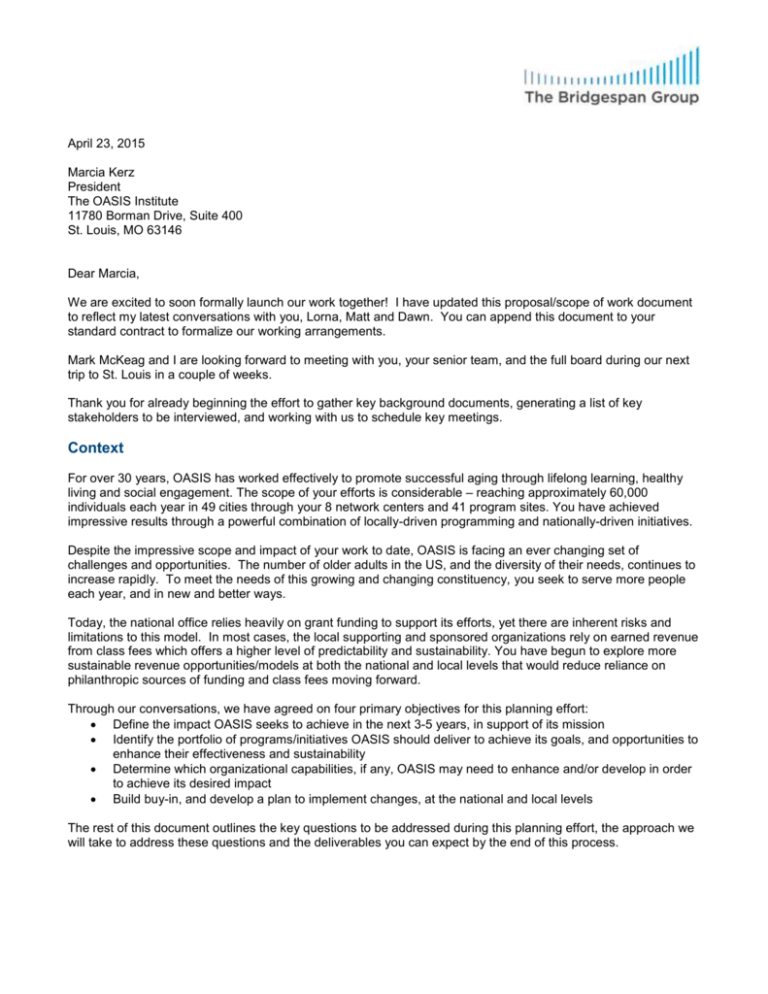
April 23, 2015 Marcia Kerz President The OASIS Institute 11780 Borman Drive, Suite 400 St. Louis, MO 63146 Dear Marcia, We are excited to soon formally launch our work together! I have updated this proposal/scope of work document to reflect my latest conversations with you, Lorna, Matt and Dawn. You can append this document to your standard contract to formalize our working arrangements. Mark McKeag and I are looking forward to meeting with you, your senior team, and the full board during our next trip to St. Louis in a couple of weeks. Thank you for already beginning the effort to gather key background documents, generating a list of key stakeholders to be interviewed, and working with us to schedule key meetings. Context For over 30 years, OASIS has worked effectively to promote successful aging through lifelong learning, healthy living and social engagement. The scope of your efforts is considerable – reaching approximately 60,000 individuals each year in 49 cities through your 8 network centers and 41 program sites. You have achieved impressive results through a powerful combination of locally-driven programming and nationally-driven initiatives. Despite the impressive scope and impact of your work to date, OASIS is facing an ever changing set of challenges and opportunities. The number of older adults in the US, and the diversity of their needs, continues to increase rapidly. To meet the needs of this growing and changing constituency, you seek to serve more people each year, and in new and better ways. Today, the national office relies heavily on grant funding to support its efforts, yet there are inherent risks and limitations to this model. In most cases, the local supporting and sponsored organizations rely on earned revenue from class fees which offers a higher level of predictability and sustainability. You have begun to explore more sustainable revenue opportunities/models at both the national and local levels that would reduce reliance on philanthropic sources of funding and class fees moving forward. Through our conversations, we have agreed on four primary objectives for this planning effort: Define the impact OASIS seeks to achieve in the next 3-5 years, in support of its mission Identify the portfolio of programs/initiatives OASIS should deliver to achieve its goals, and opportunities to enhance their effectiveness and sustainability Determine which organizational capabilities, if any, OASIS may need to enhance and/or develop in order to achieve its desired impact Build buy-in, and develop a plan to implement changes, at the national and local levels The rest of this document outlines the key questions to be addressed during this planning effort, the approach we will take to address these questions and the deliverables you can expect by the end of this process. Key Questions 1. What is the impact OASIS seeks to achieve in the next 3-5 years? o How does OASIS define the social change it seeks to achieve through its work? o What are the most important needs of older adults, and how are those needs evolving? o What is the unique value OASIS can provide to meet the needs of this growing and diverse constituency relative to other national organizations serving this population? o What is the impact OASIS has achieved to date? How does that vary across centers? 2. What portfolio of programs should OASIS offer, and where, in order to achieve its desired impact? o What is the current portfolio of programs being delivered by OASIS nationwide? How does that vary across centers/sites? What traction do the four national initiatives – Connections Technology Training, evidence-based health programs, intergenerational tutoring and CATCH Healthy Habits – have at the local level? o What is the optimal portfolio of programs (existing and potential) that OASIS should deliver nationwide? What programs should be delivered at each of the 8 network centers? How could/should that vary from center to center? o What is the optimal geographic footprint for OASIS? Does OASIS need to expand/contract the number of centers/sites in order to achieve its goals? 3. How can/should OASIS deliver this portfolio of programs effectively and sustainably? o How are programs delivered and sustained today? What is the role of the national office in supporting program delivery? What capabilities exist today at the national level and at the centers? What role do partner organizations play in supporting program delivery? What is the fully-loaded cost to deliver each program? How does that vary across centers? What revenue streams are associated with each program? How does that vary across centers? What effective program delivery and/or funding practices exist across the network that could be leveraged more broadly (i.e., “bright spots”)? o How should programs be adapted to enhance effectiveness and sustainability? How does OASIS define sustainability? What portion of costs (e.g., 50%? 70%?) should be covered by grants/philanthropy (nationally and at the local level) versus other sources? How might this vary by program/initiative based on maturity and availability of alternative revenue sources? What are the most promising opportunities to streamline program delivery to reduce costs? What are the biggest revenue opportunities for OASIS (overall, for each program, and across centers)? What might customers be willing to pay for OASIS programs? Beyond fee-for-service, what other revenue models (if any) have potential for OASIS? How can OASIS drive additional volume? How can OASIS attract younger participants at its centers/sites? What are more highly leveraged ways to attract participants? 4. How will OASIS need to evolve, as an organization, to achieve its desired impact? o How is OASIS structured today to deliver on its mission? o Which capabilities reside at the national office versus at the local level? Are there capabilities which will need to be enhanced and/or developed at the national (or local) level to support growth and effective and sustainable program delivery? o What opportunities exist for OASIS to employ best-in-class/”highest bang for the buck” practices in its core functions (e.g., marketing)? How can good practices from one part of the network be shared more quickly across the entire network? o What new types of partnerships may be needed, nationally and/or locally, to enhance the effectiveness and sustainability of program delivery? 2 Approach Our work together will unfold in three phases over a 5 ½ month period (June 15 – November 30, 2015): 1. Build a robust fact base, 2. Establish goals and identify/test options to enhance effectiveness and sustainability, and 3. Draft the plan and lay the groundwork for implementation. We are glad that you have designated a Business Planning Committee, consisting of local and national board members, to engage more actively in the planning process and we look forward to working closely with them. Throughout our work together, we will hold regular working sessions with OASIS’s senior leadership at which we will share analyses and insights from our data gathering and seek your feedback. We also anticipate engaging leaders at all 8 network centers and hope to visit most (if not all) of them to better understand the current model, challenges and opportunities, and to ensure that local perspectives are represented throughout this process. To the extent possible, we will try to schedule site visits to coincide with local board meetings. Phase 1: Build a robust fact base (~2.5 months) During this phase, we will develop a detailed understanding of OASIS’s historical impact and current operating model(s). In our experience, it is critical that we help you develop a deep understanding of OASIS’s “current state” as well as an understanding of the variability you see in impact, operations and sustainability across the network. We would also begin to identify potential strategic options for OASIS to consider that could enhance effectiveness and sustainability. Specific activities during this phase would include: Gather and review OASIS data and key strategic/operational documents (at the national and local levels) Interview board members as well as leadership of national office and centers to understand current model, challenges and opportunities Conduct site visits with centers that will include interviews of current and potential customers (e.g., nonprofits, schools, libraries, etc) to understand needs and opportunities Conduct an organizational assessment/diagnostic with an eye to understanding where capabilities currently reside and opportunities for enhancing existing capabilities Conduct working sessions with OASIS senior leadership team and Business Planning Committee Phase 2: Establish goals and identify/test options to enhance effectiveness and sustainability (~2 months) During this phase, we will further identify and assess potential options for OASIS to enhance the effectiveness and sustainability of its programs. We will model the potential mission and financial impact that each of those options would represent, as well as the strategic and operational tradeoffs among the options. We will facilitate discussions with OASIS leadership and board members that will lead to strategic decisions about the most promising path forward. Activities in this phase would include: Work with OASIS senior leadership and Business Planning Committee to articulate 3-5 year goals for the organization Develop a set of promising options by which OASIS could enhance its impact and sustainability (e.g. opportunities to increase participation in, or outcomes, of existing programs; opportunities to reduce costs and enhance revenues for existing programs; opportunities to add new programs to the portfolio, etc) Use analyses and facilitated sessions to deeply assess the impact and potential of each option. This would include an assessment of the impact of the options on the current operating model, financial modeling, an assessment of organizational capabilities and partnerships required at the national and local level, an assessment of differences in program delivery across centers, implications for implementation, etc. Conduct working sessions with OASIS senior leadership team and Business Planning Committee (Potentially) Facilitate a meeting or retreat with the staff and the full board to align on key strategic options to achieve OASIS’s 3-5 year goals 3 Phase 3: Draft plan and lay groundwork for implementation (~1 month) During this final phase, we would write up the final plan document and prepare OASIS to successfully implement the agreed-upon strategy. Our work in this phase would build heavily on our work together in the prior two phases, during which we will have established your 3-5 year goals as well as the needs and capabilities of your organization, programs, and stakeholders. Specific activities during this phase would include: Draft final deliverable Develop high-level implementation roadmap based on the goals and strategy (i.e., with key activities timelines, milestones, key check-points, owners, etc.) Conduct individual meetings/working sessions, as needed, with the staff and other stakeholders, to ensure all are aware of what will be needed to achieve the goals and strategy and to ensure momentum towards implementation Deliverables By the end of the project, Bridgespan will deliver the following: A business plan with well-defined 3-5 year impact goals; a robust fact base of OASIS’s current impact, operations, organization and financials; and a set of strategic initiatives OASIS will pursue to achieve its goals A high-level implementation plan with key activities, timelines, milestones, owners, etc. around which the staff and board is aligned Documentation of the key inputs, perspectives, choices and criteria considered in this planning process Bridgespan Team & Resources I will be leading this work along with Mark McKeag, a senior Bridgespan Manager (our bios are below). We will be supported by two additional consultants. The professional fees for this project will be $375,000, inclusive of our travel costs. We will invoice in three installments of $125,000 each on June 15, September 15, and November 30. 4 Bridgespan Leadership Bios Taz Hussein, Partner Taz Hussein is a partner in The Bridgespan Group’s Boston office and Head of the Public Health Practice. Taz has worked with numerous nonprofit and foundation clients on a range of core public health and healthcare issues, including increasing health insurance coverage and access to care, improving health outcomes for disadvantaged populations, and disease prevention. Over the past several years, Taz has led engagements with a diverse set of nonprofits such as the Harlem Children’s Zone, the YMCA of the USA, Cure Violence (formerly known as CeaseFire), the National Council for Behavioral Health, the National Network of Public Health Institutes, and the Center for Health Care Strategies. Taz has also worked extensively with health philanthropies including the Robert Wood Johnson Foundation, Blue Cross Blue Shield of MA Foundation, MetroWest Health Foundation, the Endowment for Health, the Health Foundation for Western and Central NY, the NY State Health Foundation, and the CDC Foundation. Recent articles and blogs authored by Taz include: “A National Growth Plan Rooted in One State’s Success,” written with co-author Sridhar Prasad, Stanford Social Innovation Review (Jan. 12, 2015) “Using National Networks to Tackle Chronic Disease,” written with co-author Michaela Kerrissey, Stanford Social Innovation Review (Winter 2013); and, “The future of healthcare is here: Partnerships with community-based organizations,” Philadelphia Social Innovations Journal (January 2013) Prior to Bridgespan, Taz was a consultant at McKinsey & Company. Earlier in his career, Taz spent several years in the nonprofit sector working with advocacy, human service and public health organizations addressing issues of homelessness, substance abuse and access to care for people with HIV/AIDS. Taz earned his Bachelor of Science in Mathematics from MIT and his MBA from the Harvard Business School. Mark McKeag, Manager Mark McKeag is a Manager in Bridgespan’s Boston office. Since joining the firm in 2011, Mark has advised leaders in nonprofits and foundations across the public health, education and youth development sectors on strategic, organizational and economic issues. Mark is a member of Bridgespan’s public health practice area and has worked on a range of issues to improve health outcomes for disadvantaged populations – most notably in the area of diabetes prevention. Mark also has a depth of experience working with large national nonprofit networks including YMCA of the USA, Boys & Girls Clubs of America and The Salvation Army. Prior to joining Bridgespan, Mark was a Managing Director of Regional Development at Teach For America, responsible for development, growth strategy, and capacity building for 15 Teach For America regions. Prior to his time at Teach For America, Mark was a Case Team Leader at Bain & Company in Boston where he advised corporate and nonprofit clients on strategic and operational issues, and private equity firms on investment decisions. Mark graduated cum laude from Duke University with a BS in Biomedical Engineering. He also holds a Master of Public Policy from Duke’s Sanford School of Public Policy and an MBA from Duke’s Fuqua School of Business, where he was named a Fuqua Scholar. 5

